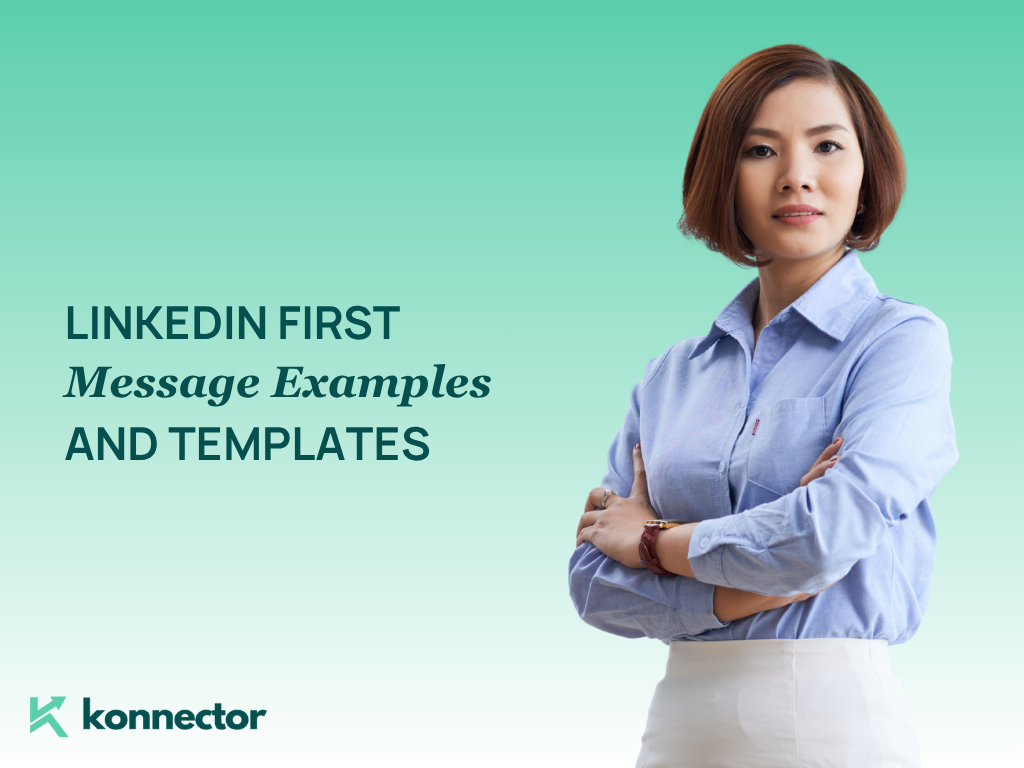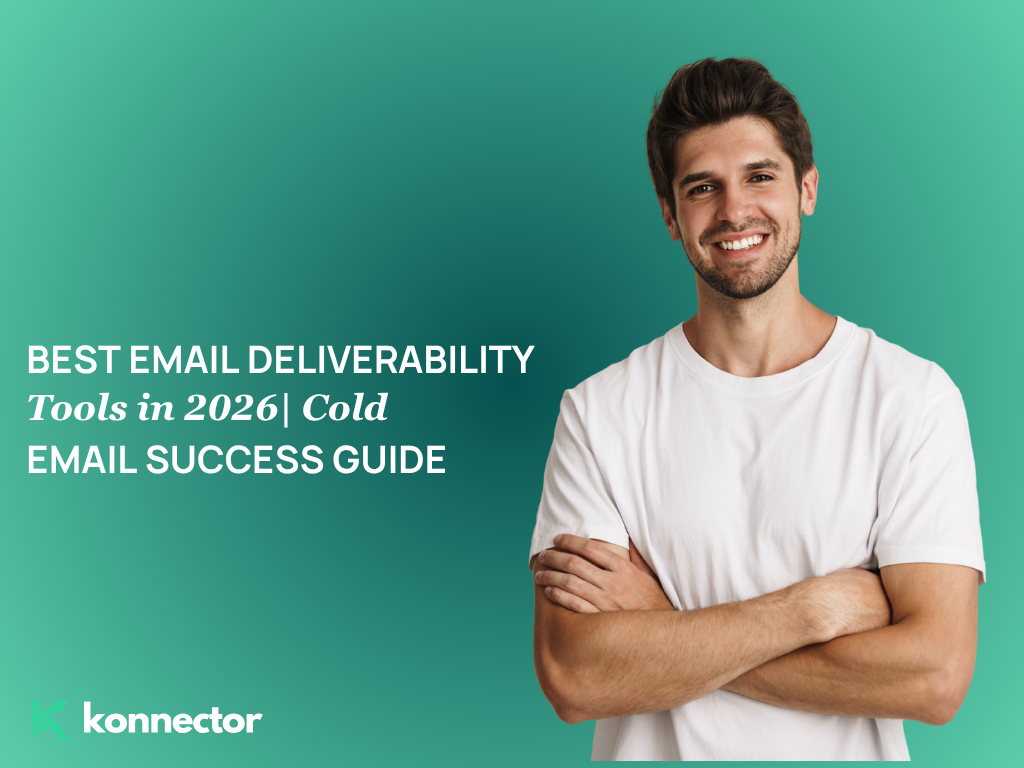LinkedIn First Message Examples and Templates
Ever sent a connection request that disappeared into the LinkedIn void? You’re not alone.
The difference between being ignored and getting a reply often comes down to your first message.
In a world where inboxes overflow with automated “let’s connect” spam, the first message you send needs to do one thing: feel human.
At Konnector.AI, we’ve analyzed thousands of LinkedIn conversations to uncover what actually drives responses — and more importantly, how you can automate it without losing the personal touch.
Why Your First Message Matters More Than You Think
The first message is your virtual handshake. It’s not about selling; it’s about starting a micro-conversation that earns curiosity.
- First impressions: 68% of prospects decide within seconds whether to accept your request.
- Trust signals: A relevant opener creates psychological comfort — “this person gets me.”
- Engagement gateway: A thoughtful first message sets up smoother follow-ups and higher reply rates later.
Think of it as starting a coffee chat — not delivering a sales pitch.
How to Craft a Perfect LinkedIn First Message
Every high-performing message follows the same 3-step framework: Context → Relevance → Light CTA.
- Context: Mention something real — their post, company, or shared interest.
- Relevance: Connect it to what you do or believe, not what you’re selling.
- Light CTA: End with an easy yes — something conversational, not commercial.
Example structure:
Hey [Name], loved your recent post on [Topic]. I’ve seen similar challenges with [Insight]. Would love to stay connected and share ideas sometime.
Do you know how to Choose the Right Keywords for LinkedIn Profile?
5 Proven LinkedIn First Message Templates That Work
1. The “Post Engagement” Message
Best for when your prospect has shared content recently.
Hey [Name], saw your post on [Topic] — completely agree about [Specific Point]. Curious, have you seen any recent shifts in [Related Area]? Would love to connect!
Why it works: It feels genuine and relevant — no sales, just shared curiosity.
2. The “Mutual Interest” Opener
Ideal when you have something in common — groups, industries, or causes.
Hi [Name], noticed we’re both part of [LinkedIn Group] and share an interest in [Topic]. Always good to connect with others in the space — hope to exchange thoughts soon!
Why it works: Common ground builds instant rapport without effort.
3. The “Compliment with Purpose” Message
Perfect for decision-makers or thought leaders.
Hey [Name], your interview on [Podcast/Event] had a great takeaway about [Insight]. Loved your point on [Topic]. Would be great to connect and follow your updates!
Why it works: It flatters sincerely and positions you as a peer, not a seller.
4. The “Industry Relevance” Message
For prospecting within a specific niche or vertical.
Hi [Name], I work with several [Industry] teams focused on [Challenge]. Noticed your company’s doing great things around [Specific Topic]. Thought it’d be great to connect and swap ideas!
Why it works: Shows understanding of their world — not just generic networking.
Learn how to add an outbound link to a LinkedIn Post!
5. The “Conversational Humor” Message
When appropriate, a little levity can stand out.
Hey [Name], I saw your headline and thought, “finally, someone who gets it!” Always refreshing to meet people who make [Industry] sound fun. Let’s connect before Monday hits again 🙂
Why it works: Humor lowers resistance — and makes your message feel memorable.
Watch: How to Scrape Leads from LinkedIn “Events” | Konnector.ai Tutorial
How to Personalize at Scale Using Konnector.AI
Manually writing unique messages works — until you need to send 500 of them. That’s where smart automation bridges the gap.
With Konnector.AI, you can:
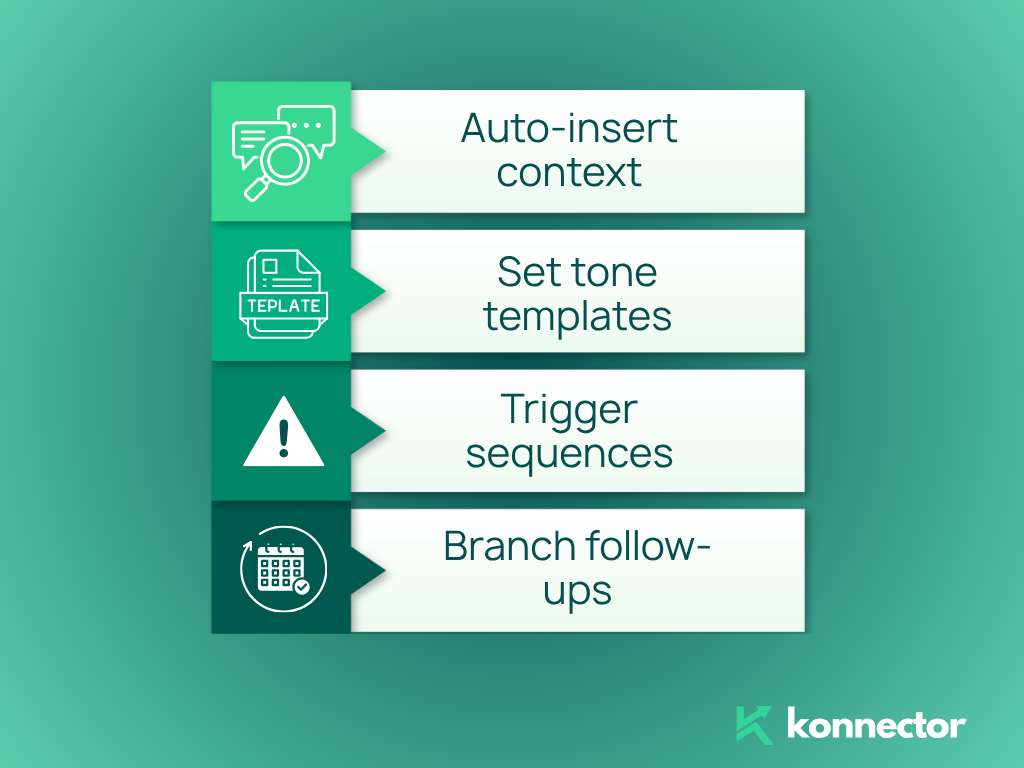
- Auto-insert context: Use AI to detect recent posts, company details, or profile keywords in your first message.
- Set tone templates: Choose between friendly, professional, witty, or insightful tones for your outreach.
- Trigger sequences: Send first messages automatically after a profile visit, post engagement, or comment.
- Branch follow-ups: If they accept but don’t reply, Konnector sends a soft second message to continue the conversation.
Example workflow: Someone engages with your post → Konnector sends a contextual connection message → Follows up with a tailored note if accepted.
Common Mistakes in LinkedIn First Messages (and How to Fix Them)
- Too generic: “I’d love to add you to my network” doesn’t cut it. Add one personalized line based on their profile or post.
- Pitching too early: Don’t sell in the first message — connect first, converse later.
- Over-explaining: Keep it light. Your first goal is a connection, not a contract.
- Ignoring tone: Match the person’s vibe — formal for execs, relaxed for creatives.
- No CTA: End with something that invites engagement — even if it’s as simple as “Would love to connect.”
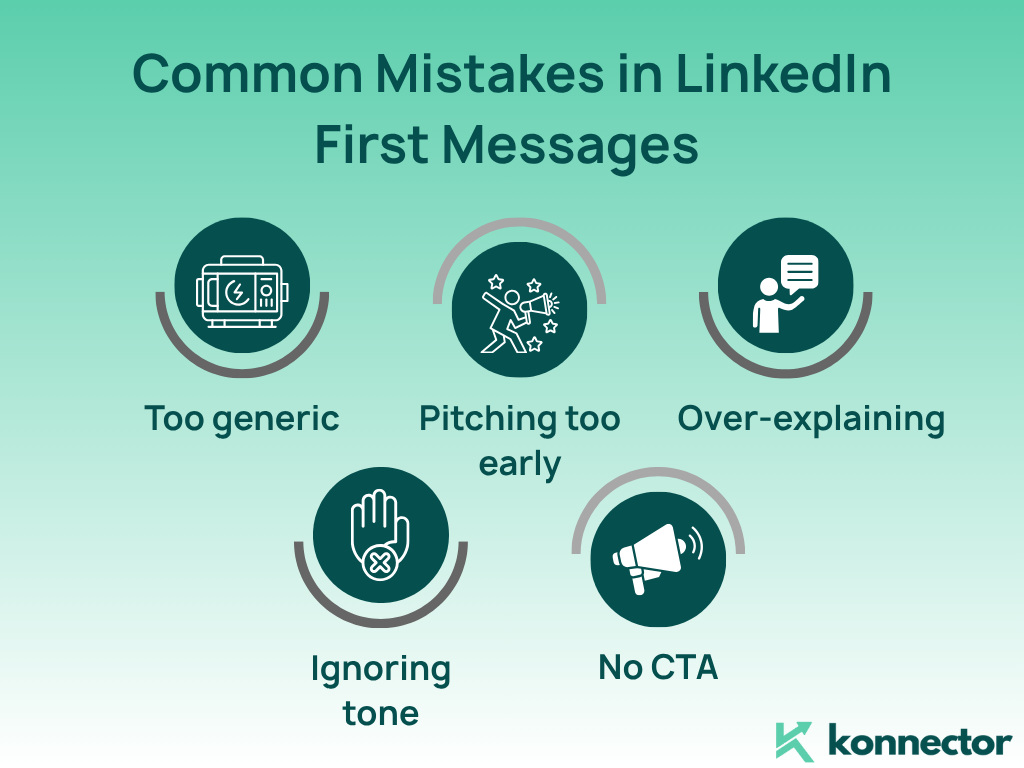
Pro Tip: The “Second Message” That Seals the Connection
Once they accept your request, don’t stop there. Your second message determines if this turns into a real conversation.
Hey [Name], appreciate the connection! Curious — are you focusing more on [X] or [Y] this quarter? Been seeing both directions trending lately.
This approach keeps the chat open-ended and insightful, not transactional.
The Konnector.AI Advantage
The best outreach doesn’t just scale — it scales with warmth. With Konnector.AI, you can:
- Automate personalization: AI crafts first messages that feel tailor-written using context tags like {{first_name}} and {{recent_post}}.
- Engage automatically: Set up smart triggers for connection requests and follow-ups after engagement.
- Measure impact: Track acceptance rates, replies, and engagement levels to refine future campaigns.
- Stay authentic: Every automated message keeps your tone and brand intact — no robotic outreach here.
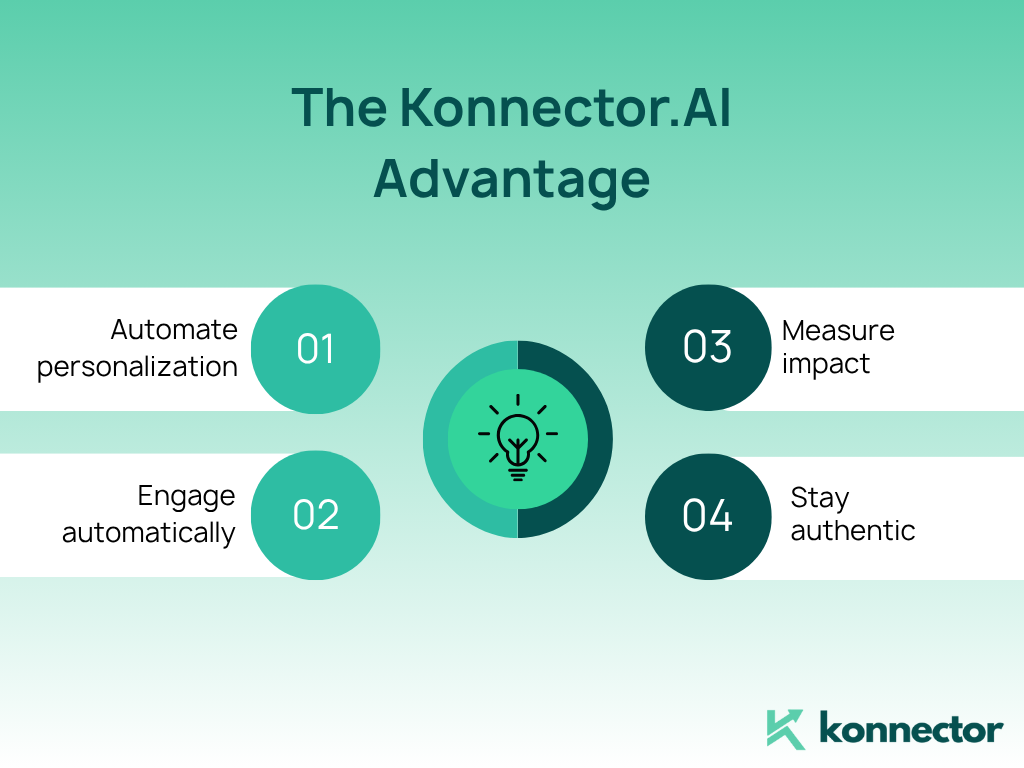
In short: Let AI handle the outreach volume, so you can focus on the conversations that close deals.
Final Takeaway
Your first message on LinkedIn is your digital handshake — make it warm, relevant, and effortless to reply to.
With Konnector.AI, you don’t have to choose between personalization and scale. You can send hundreds of connection requests that still sound like one-on-one conversations.
Connect authentically. Automate intelligently. Start conversations that actually convert.
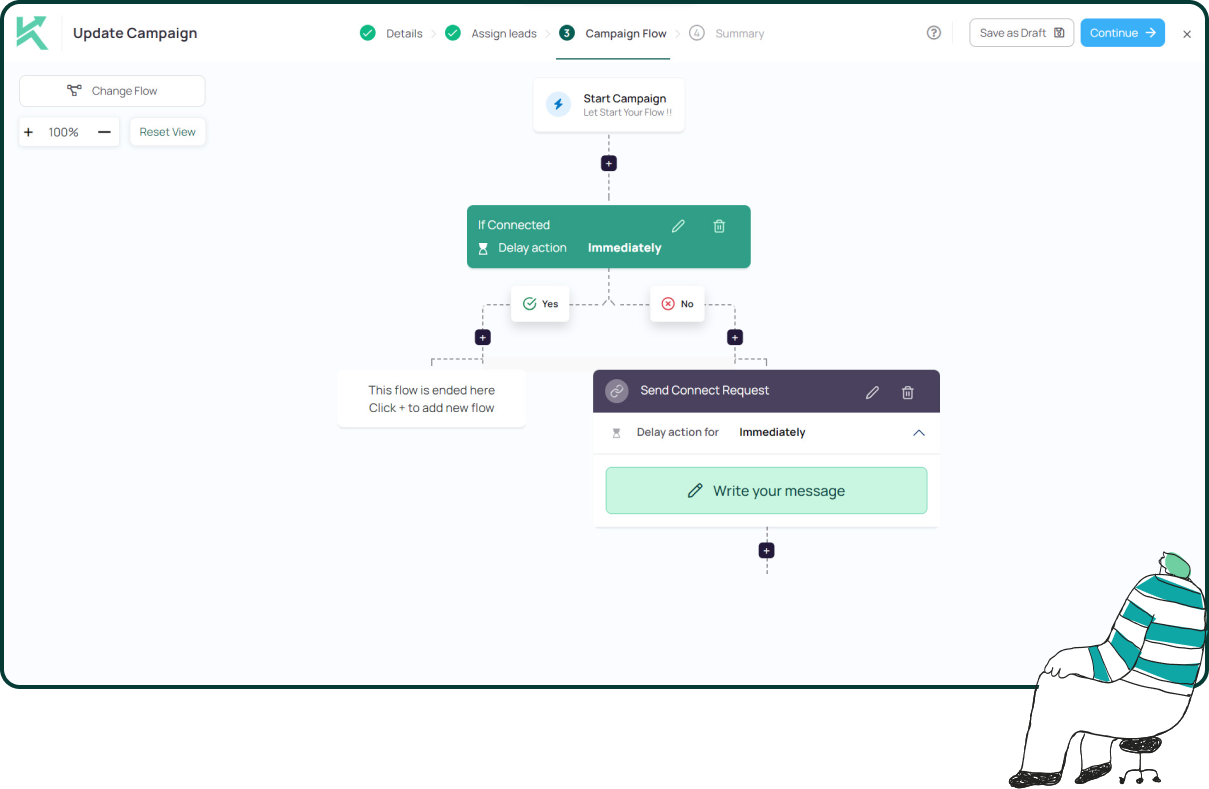
11x Your LinkedIn Outreach With
Automation and Gen AI
Harness the power of LinkedIn Automation and Gen AI to amplify your reach like never before. Engage thousands of leads weekly with AI-driven comments and targeted campaigns—all from one lead-gen powerhouse platform.
Frequently Asked Questions
It’s the first message or connection request you send to a new prospect — designed to spark interest, not pitch your product immediately.
Because it sets the tone for the entire conversation. A strong opener can earn trust, while a generic one gets ignored.
Personal relevance, short length, and conversational tone. Mention a shared interest, post, or insight before introducing your offer.
Ideally 3–4 short lines. Enough to show relevance and curiosity without overwhelming the recipient.
Yes, always. Messages sent with connection requests see higher acceptance rates than blank invites.
Pitching too soon, using templates without personalization, or leading with “Hi, I’d love to add you to my network.”
Yes. Tools like Konnector.AI let you automate personalized first messages using tags, tone settings, and smart branching workflows.
“Hey [Name], saw your post on [Topic] — great insight on [Specific Point]. Would love to stay connected and share notes.”
Run A/B campaigns using Konnector’s AI outreach tools to track which intros get the highest acceptance and reply rates.
Wait 2–3 days, then send a soft follow-up if there’s no response — ideally referencing something relevant or value-driven.


